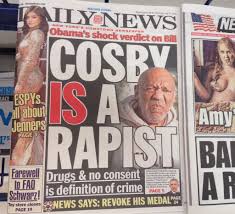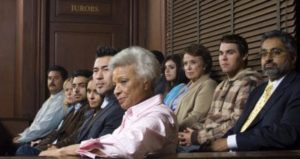After years of accusations that went unheard and a hung jury in a previous criminal trial, a Pennsylvania jury finally convicted Bill Cosby of criminal sexual assault.

Part of me feels, “Hallelujah! Finally, the day has come!”
Part of me is very nervous about how that verdict was achieved.
What made the difference between the first trial and this one?
It was not only what was going on outside the courtroom.
In the first trial, as Washington defense attorney Barry Coburn commented to a journalist, “It’s going to be basically two people in the room and they’re going to have very different versions of the event… And the jury is going to have to decide.”[1]
In the retrial, the judge allowed five other women who accused Cosby of similar assaults to testify — to show that this was part of a pattern of conduct that went back many years.
I have no doubt that this was the deciding difference.
When any individual or organization is accused of bad conduct, inevitably one of the first questions jurors ask is, “Well, have they done this before?” As one of my graduate school professors, Laura Nader, used to tell us, “Three instances is enough to establish a pattern.” I’ve found her dictum to be quite accurate. This is the answer of a qualitative researcher and a storyteller, not a statistician, mind you. But our human minds are not designed to think like statisticians. We are biased to find patterns in a small number of instances, which is why we can see the face of Jesus in a tortilla, animal figures in clouds, and guilt in a series of accusations, as happened in the McMartin child abuse scandal of the 1980s.
Judges know that jurors want to know if someone has “done it before.” The law knows this too. This is why judges so often exclude such evidence as being more prejudicial than probative. In criminal cases, generally, the jury must decide on the single instance charged. Even if the defendant were convicted of a similar crime, usually that evidence is not allowed in during the guilt phase of the trial; only the judge can consider this evidence during sentencing — if a defendant is found guilty.
And this is why I have mixed feeling about Cosby’s conviction.
Was he guilty? Based on what I know, I have absolutely no doubt.
He was able to get off before partly because the law makes it difficult to show a criminal’s pattern. He relied on the protections of the law in a way that, let’s be honest, contributes to cynicism about the law.
But was it right to allow five women to testify who had not yet proven their own cases against Bill Cosby?
You might say, Well, let the jury decide if their testimony is credible. That’s the jury’s job, and they are up to the task.
The problem is that it’s not clear that they are up to the task, or that any jury would be in these circumstances.
Why did the judge allow this testimony in the first place? It’s hard not to conclude that he allowed it because of the #MeToo movement — and the huge surge of concern and awareness about the number of powerful men using their power and positions to take advantage of women — because, legally, I don’t believe that anything changed. Judges are people too, and subject to the same judgments and pressures as we all are.
If I’m right and the judge was influenced by extrajudicial factors, that’s both a violation of a judge’s duty and a sign that jurors were subject to the same forces. And that’s when confirmation bias comes into play: looking for evidence that supports our beliefs and minimizing, ignoring, or not even being aware of evidence that contradicts them. And that’s when people get railroaded by the State into prison.
It’s easy to feel satisfied when someone who seems to have long eluded the law is finally convicted — and revealed to be the criminal he is. But it’s dangerous to justify the process by achieving what we “know” is the right result. That presumes we have the ability to know who is guilty before the trial, before the evidence, before the process. Humans are easily subject to the delusions of the crowd and the pressures of the group. We like being with the “in” group, and our thinking is malleable. We often pay more attention to the opinions and feelings of others than to the evidence. That is precisely why the rules of evidence and the protection of the law are so vital in criminal defense.
This danger is not theoretical. As Rick Jones, current President of the National Association of Defense Lawyers (NACDL), writes about it in his most recent column, every year, dozens of people are convicted of crimes that they did not commit because the prosecution fails to turn over exculpatory evidence – as they are required to do by law. In other words, prosecutors break the law to achieve a conviction. But if judges start to bend the rules of evidence as well, there is no check in the courtroom on the considerable and unrelenting power of the state.
If you are not aware of the history of the McMartin child sexual abuse accusations and criminal trial, read the Wikipedia article that tells the sad tale to see how much damage can be wrought when people jump on a bandwagon and are convinced that they know the truth.
Today, with a polarized climate in which so many people on all sides believe that they know the truth while others lie and ignore evidence, it is particularly dangerous to forgo the protections of our criminal process.
Fortunately, in the McMartin case, despite 6 years of criminal trials, there were no convictions — not because the guilty went free, but because the protections of the criminal process worked as designed. If they come for you, or your child, or someone you care about in your life… Enough said. Process matters precisely because the truth can be harder to find than we imagine. All of my prosecutor and criminal defense attorney colleagues and friends know that, where they toil in the shadows of our justice system.
[1] http://www.wfmz.com/news/cnn-national/bill-cosbys-trial-comes-down-to-he-saidshe-said/527455928 accessed April 27, 2018





